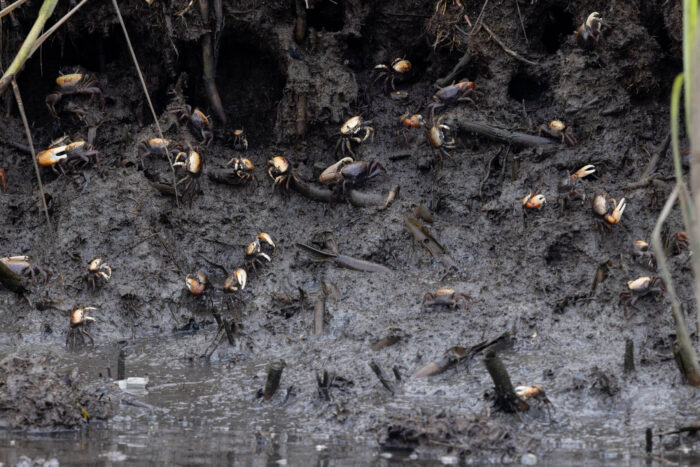Fiddler crabs
Ocypodidae
Fiddler crabs are small crustaceans with a distinctive enlarged claw. They live on beaches, mud flats and marshes throughout the Chesapeake Bay.
This section shows one large critter image at a time. Use the thumbnails that follow to select a specific image to display here.

This gallery contains a grid of small thumbnails. Selecting a thumbnail will change the main image in the preceding section.
Appearance
Three species of fiddler crabs can be found in the Chesapeake Bay region:
- The red-jointed fiddler crab, Minuca minax
- The marsh fiddler crab, Minuca pugnax
- The sand fiddler crab, Leptuca pugilator
Fiddler crabs vary in color from tan to brown. Sand fiddler crabs are lighter than the other two species. Males have one enlarged claw that can grow to 1.5-2 inches long while females’ claws are equal size. The carapace (shell) is squared with rounded rear edges. The red-jointed fiddler crab’s shell has a groove behind each eye. Male marsh fiddler crabs have a royal blue spot on the center of the carapace, while male sand fiddler crabs have a blue or purplish shell. Shells vary in size from less than an inch wide to 1.5 inches wide. The marsh fiddler crab is the smallest fiddler crab in the Bay region and the red-jointed fiddler crab is the largest. Fiddler crabs have four pairs of walking legs.
Feeding
Fiddler crabs eat algae, bacteria and decaying marsh plants. They feed by sifting through sand or mud for food particles. They often eat in a puddle of water to help separate food from sand. Females have an advantage over males for finding and eating food because both their claws are small. The adult male’s major claw makes feeding more difficult.
Reproduction and life cycle
Fiddler crabs mate every two weeks in summer. Males dig, maintain and defend a tiny, sometimes elaborate burrow for mating, sleeping, refuge, and “hibernating” during winter. To find a female partner, males stand next to their burrow while females walk past. The males wave their large claw to attract a female’s attention. If a female is interested, she will stare at a male for a short period of time. The male then runs toward the female and runs back to his burrow. He repeats this motion several times until the female either moves on or follows him.
If the female follows, the male drums the edge of the burrow with his claw, then leads the female inside, plugs the entrance and returns to the female to mate. Females incubate their egg sponge for two weeks before returning to the surface. They release the eggs into the water, where they hatch and develop into juveniles. Fiddler crabs molt once or twice per year. During the soft-shelled period, fiddler crabs remain in or near their burrow.
Did you know?
- The red-jointed fiddler crab is the most common and widespread fiddler crab in the Bay region
- You can identify a fiddler crab species by examining its enlarged claw: the sand fiddler crab’s claw is smooth on the underside. If the claw is not smooth on the underside and had red joints, it is a red-jointed fiddler crab. Otherwise, it is a marsh fiddler crab.
- Red-jointed and marsh fiddler crabs live in muddy areas in marshes. Red-jointed fiddler crabs are more tolerant of low salinities. Sand fiddler crabs live on sandy, salt and brackish beaches and flats; they cannot survive in muddy areas because they can only feed over sediment particles of a certain size.
- The male’s enlarged major claw is not for fighting predators, but primarily to attract a mate and discourage rivals.
- If a male loses its major claw, the remaining claw grows to the same size as the lost claw. The new claw that grows becomes the smaller claw.
- Although the male’s major claw is large, fiddler crabs are not especially dangerous to handle. But be careful – the claws can break off easily.
Sources and additional information
- Life in the Chesapeake Bay by Alice Jane Lippson and Robert L. Lippson
- Chesapeake Bay: Nature of the Estuary, A Field Guide by Christopher P. White
- Animal Diversity Web: Uca minax, Uca pugnax and Uca pugilator – University of Michigan Museum of Zoology
